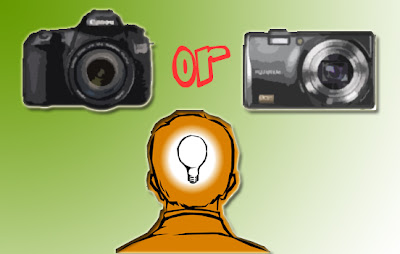It is almost normal for every family to own at least a camera these days. And if you are thinking of buying a new camera for the holiday season, you might be wondering which type of camera you should get. With the Digital Single Lens Reflex (DSLR) cameras getting more popular, it's no wonder if you are thinking of switching to the Big DSLRs instead of keeping your compact Digital Still Cameras (DSC). But is it worth the upgrade? Well, hopefully, after reading through this post, you'll find your answer.Comparing Prices:
In terms of prices, the cheapest DSLR camera I know is priced at $699 ( Sony A290L Single Lens Kit) and can cost as high as $12 799 (Canon 1DS Mark III body only). For DSC, they come in range of prices but hardly any cost more than $900 dollars.
The usual $699 DSLR is the entry level of the DSLR cameras and is usually with minimal functions such as 2.5 FPS for cont. shooting, no live view etc. Using the same value, $699 can get almost "state-of-the-art" compact cameras like Canon's Powershot S95 (semi-pro) or Sony's DSC TX9 (compact slim camera) with functions such as HD movie recording, High Speed Cont. Shooting, ISO as high as 3200 (depending on individual models).
Comparing Functions:
In compact DSC, there are many "automatic" scene modes that you can choose from like Night Portrait, Children, Sports etc (depending on the models of your camera). Lately very common in DSC is the Automatic Scene Reconition function (the name varies from brands to brands but it's the same function), which made photography much easier for the general public. They usually would detect the object/subject and change the scene modes accordingly. For example, when taking a close-up shot, one no longer need to manually turn on the Macro Mode, the camera automatically senses and and changes its photo setting so you can get a good shot almost every time. Some brands of cameras also have special scenic modes like Casio, Fujifilm & Olympus cameras have Beauty Modes where they apply a softening effect on your portrait photos. Canon cameras have features like fish-eye effect, miniature effect apply to the photos as well.
DSLR on the other gives you more control over what you can do. The DSLR cameras give you the ability to control shutter speed and aperture. With the control of Shutter Speed and Aperture, you can do wonders, like capturing 1 drop of rainwater in the midst of a down-pour or get a misty flowing effect when taking waterfalls.
Picture Quality:
In terms of picture quality, I would say if you know how to operate a camera, both DSC and DSLR cameras can give you photos that are sharp & clear. If you know how to press the "half shutter" then it almost doesn't matter, in the day that is.
For night photos, the fact that DSLR allows you to adjust the shutter speed gives it a better edge over the DSC for night shots. Longer Shutter speed allows more light to enter the camera, giving you a nice photo without the worry of under exposure. Of course, that can only be achieve through the usage of a tripod/monopod. Longer shutter speed requires the camera to be fully stablised in order for the photo to be clear. The slightest move will cost the photo to be blurred.
Some DSC cameras do "okay" night photos. It's not enough to just judge by the ISO to guage if the camera can do good night photos. This is because, the higher the ISO, the "noisier" the photo turns out to be. By NOISE, I mean the "pixelated" & "grainy" on the photos when taken at high ISO level. However, the DSC do have "night mode" which puts them at a better position then the olden days DSC.
Comparing Size:
Well, the other known name for the DSC is perhaps, compact cameras. As the name suggest, compact cameras tend to be small and fit into your bag pretty well. DSLR cameras on the hand, tend to be much bulkier, remembering you have to attach the lens to the body of the camera.
My POV:
Well, I think you might be thinking that I'm crappy but I must still say this. Unless you are interested in photography, there's absolutely no point in buying a DSLR camera. In terms of prices, DSLR cameras are really much more expensive for functions that you might not use if you have no idea how to use them. And, in my opinion, buying a DSLR camera is an investment 'cause you will need to buy more lens in the future (ranges from the hundreds to a few thousands) and other accesories as well.
But, on the other hand, if you really want to go into photography, then I would tell you, go ahead but you might want to start with the basic model first. Usually, the lens that you own is more important than the camera body that you have. The type of lens used have a direct relationship to the kind of photos that you shoot. And if you are cultivating your hobby in photography, do be prepared to spend more money because like I've mentioned, it's an investment, a chain of accesories await you once you've taken the 1st step into DSLR: tripods, monopods, lens filters, flash etc.
Hopes the above will aid you if you have trouble in deciding on a DSLR or a Compact Camera.



